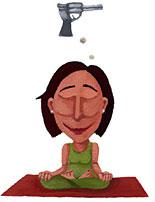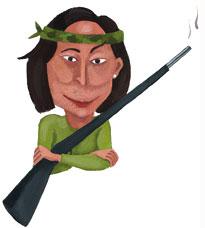I pressed the Beretta AL391 Urika deep into my shoulder and against my cheek, as if gripping a shotgun stock were as natural as holding the strap of my purse. I said, “Pull,” in a firm yet casual way, to convey that, sure I drove here in a Volvo, and the radio in the Volvo is tuned to NPR, but I’m actually the kind of woman who loves the smell of cordite in my hair. Two weeks ago I was so ignorant about firearms that I thought shotguns discharged bullets and I didn’t know the difference between a revolver and a semiautomatic. But here I was shooting trap, in which clay disks, the moving target simulating a bird in flight, are released at unpredictable angles from a small trap house. As the “pigeon” flew on my command, I swung the shotgun to follow its arc and pulled the trigger. My instructor called out, “Oh, yeah!”
“What happened?” I asked.
“You hit it,” he said.
“I did?” I replied
I called “pull” again and fired. Even I could see this orange disk disintegrate. “Pull,” pow! “Pull,” pow! My excellent instructor, Ricardo Royal, is a large man, but was surprisingly light on his feet as he did a little dance next to me and sang out, “Annie Oakley, Annie Oakley.” I took turns with my fellow student, a middle-aged man who consistently missed and who now looked as if he’d be happy to forget about the target and blast me instead. (It was a look I have provoked in many other people, who fortunately were unarmed.)
In Human Guinea Pig I engage in unusual activities and hobbies. This time I wanted to see if a novice—a nervous novice—could in a few lessons learn how to be a decent shot. I do understand that there is nothing unusual about owning firearms. Surveys show almost half of American households have them. But I live in the District of Columbia, which has one of the nation’s toughest gun laws. Residents are not allowed to own handguns, and if one of us feels a need to discharge a weapon, we are supposed to file a request with the chief of police asking for permission. (He must spend all his time answering yes, as D.C. has one of the country’s highest murder rates.)
So anathema are guns among my friends that when one learned I was doing this piece, he opened his wallet, silently pulled out an NRA membership card, then (after I recovered from the sight) asked me not to spread it around lest his son be kicked out of nursery school. My entire experience with guns consisted of a riflery class at summer camp back when Millard Fillmore was president, and an afternoon 20 years ago shooting at tin cans with a friend.
It was not easy finding an instructor willing to take on a reporter who lived in the District. Looking for help, I called Gary Mehalik, director of communications of the National Shooting Sports Foundation, who offered to get me a setup in which a laser is inserted into a pistol, which I could then shoot into a specially equipped laptop computer that would track my accuracy. I worried that at the end of a day of typing on my computer, I would become addicted to shooting it—a journalist’s version of Elvis blasting his television when he saw performers he didn’t like. Then Mehalik realized he couldn’t send me the laser-equipped pistol: “As a D.C. resident, you of course are not allowed to use a firearm.”

I located Ricardo Royal from his listing on the NRA Web site. He is an African-American, a D.C. native, and a retired paramedic who learned to shoot as a teenager through a local marksmanship club. He’s frustrated that such sporting clubs have been replaced in his city by a culture that glamorizes guns as illegal weapons. (At our first meeting, I realized how difficult it would be to separate guns from politics when Ricardo tried to enlist me to help lobby Congress to overturn D.C.’s gun law.)
Ricardo had me watch a short film as part of my gun-safety training, and in it the narrator explained that guns are simply machines. Machines can’t hurt you, he said; the danger lies in the person operating the machine. OK, I thought, but if I am inept in the handling of my blow-dryer, I am unlikely to vaporize anyone’s kidney. As he went through his safety lectures, Ricardo emphasized which firearms would be best for my “personal protection,” even though as a District resident this was virtually out of the question, and even though I assured him that no one was after me. Undeterred, his top recommendation was a pump-action shotgun. “Nothing else makes that sound,” he said, and even I could conjure up that ka-chung. “Hearing that sound alone can negate the need to fire. It makes such a sweet song.”
Ricardo met me across the border in Maryland, at the Prince George’s County Trap and Skeet Center, where he rented a shotgun for me. The plan was to shoot one box of ammunition (25 shells). I hoped I would avoid utter humiliation and hit one target, if just by accident. As we stood in the dusk, the quiet interrupted by the pop-pop-pop of gunfire from the neighboring stations, making me think how lucky I was that it wasn’t the sound of insurgents, a family of deer emerged to calmly regard us. I read in their look the knowledge that the lady with the Volvo was no threat.
The ammo itself made me uneasy, as if it could explode on contact, and I fumbled as I tried to load the shotgun. The first few shots didn’t go well. I could hear my blood pumping in my ears, and I realized that when you close both eyes as you pull the trigger, your clay target will fall to the ground intact. I slowed my breath, forced myself to keep one eye opened, and miraculously hit the thing. In the end I blasted 11 out of 25. Ricardo was thrilled and so was I. I felt even better about myself when, after I made Ricardo shoot a box of ammo, he hit only two more targets than I did.
It’s not unusual for a woman to quickly shoot well, he said. “She tends to listen to detail more precisely, and she has no preconceived notion she knows what to do.”
Before I slinked back to my now-embarrassing Volvo, I stopped to watch two men shooting. They were fast and fluid and the targets shattered one after another. I am happily married, but I found myself thinking these two—whose faces I couldn’t even make out—were awfully attractive. It brought to mind a newspaper article from a few years back. After the death of Hugh Culverhouse Sr., the owner of the Tampa Bay Buccaneers, his various entanglements caused his widow to sue his estate. During the court proceedings, it was revealed that Culverhouse had an affair with the wife of a now-deceased television anchor. Culverhouse’s son testified that the caretaker of his father’s ranch told him that the caretaker would escort the anchor’s wife and Culverhouse “into the woods and they would shoot guns and basically have sex.” I thought the article was hilarious at the time. Now I understood.
After my trap-shooting triumph with the shotgun, Ricardo was going to teach me to shoot pistols. They terrified me. I recalled Woody Allen as an inept bank robber in Take the Money and Run, handing the teller a note that read, “I have a gub.” I thought the world would be safer if I stuck to gubs. But in the classroom, as I gripped the unloaded .38-caliber Smith & Wesson Model 10 revolver, scenes from Clint Eastwood movies rushed through my head. I forced myself not so say, “Go ahead, make my day.” The human hand feels like it was designed to handle a pistol. It feels as natural as a shot glass or a cigarette, and I suddenly understood why we have a Bureau of Alcohol, Tobacco, Firearms, and Explosives (or the Bureau of Things You Like To Fool With That Can Be Bad).
A few days later I met Ricardo at the pistol range at the bucolic Izaak Walton League in Damascus, Md. Along to record the event was Dianna Douglas, a producer from NPR. I had asked her if she had any experience with guns, thinking she might want to do some shooting. “No, no, no, no, no,” she replied with a laugh. “I’m not going to want to shoot any guns. No, no, no, no, no.”
I stepped up to the line and looked at the target—a paper plate with a 3-inch black bull’s-eye—Ricardo had stapled to a pole 21 feet away. A few days before I had taken a yoga class, and during the breathing I envisioned myself aligning the gun’s front and back sights and slowly squeezing the trigger. Now I held the revolver, cocked the hammer, and shot. I hit the plate just southeast of dead center. Ricardo told me to keep going, and I start to punch a hole in the target. Maybe I could teach yoga at the NRA!
I switched to a Beretta 92FS 9 mm Parabellum semiautomatic and again I punched a decent hole. Ricardo then let me try his Sig Sauer P226 9 mm with the crimson trace laser-grip. With this gun, when you put your finger on the trigger a red laser dot illuminates your target. Ricardo had me load the magazine with 15 bullets. (From watching movies, I had thought magazines came already loaded, which I realized was like thinking candles came already lit.) After a few shots around the center of the plate, Ricardo told me to get in a faster rhythm, and I found myself hitting with greater accuracy. “Go ahead, paper plate, make my day.”
After I emptied the semi, Dianna came up hesitantly. “Umm, how hard would it be for me to umm, shoot a few rounds?” she asked Ricardo. I said, “I told you so.”
“Well, you look like such a badass doing it, I want to try,” she explained.
Ricardo had me be Dianna’s instructor on the revolver. After I explained the basic safety rules she timidly reached for the gun. “My hands are so cold,” she said as she touched it.
“Happiness is a warm gun,” I replied, aware that John Lennon, who wrote those lyrics, was gunned down by a madman. Dianna shot well.
My lessons were over, and Ricardo walked me to the parking lot to say goodbye. He handed me a piece of paper. It was from the NRA, a certificate saying I had successfully completed its basic pistol course. I got in my car and turned the key. The sounds of NPR came through the speaker. I felt confused. NPR or NRA? NPR or NRA? Then I thought of a line from another movie, Chinatown: “She’s my sister! She’s my daughter! My sister, my daughter. She’s my sister and my daughter.”
